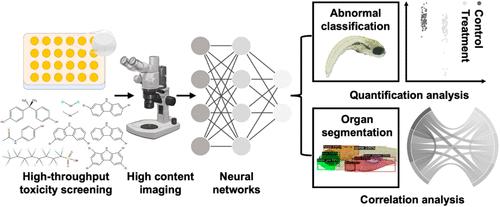当前位置:
X-MOL 学术
›
Environ. Sci. Technol.
›
论文详情
Our official English website, www.x-mol.net, welcomes your
feedback! (Note: you will need to create a separate account there.)
Deep Learning-Enabled Morphometric Analysis for Toxicity Screening Using Zebrafish Larvae
Environmental Science & Technology ( IF 10.8 ) Pub Date : 2023-03-27 , DOI: 10.1021/acs.est.3c00593 Gongqing Dong 1, 2 , Nan Wang 1, 2 , Ting Xu 1, 2 , Jingyu Liang 1, 2 , Ruxia Qiao 1, 2 , Daqiang Yin 1, 2 , Sijie Lin 1, 2
Environmental Science & Technology ( IF 10.8 ) Pub Date : 2023-03-27 , DOI: 10.1021/acs.est.3c00593 Gongqing Dong 1, 2 , Nan Wang 1, 2 , Ting Xu 1, 2 , Jingyu Liang 1, 2 , Ruxia Qiao 1, 2 , Daqiang Yin 1, 2 , Sijie Lin 1, 2
Affiliation

|
Toxicology studies heavily rely on morphometric analysis to detect abnormalities and diagnose disease processes. The emergence of ever-increasing varieties of environmental pollutants makes it difficult to perform timely assessments, especially using in vivo models. Herein, we propose a deep learning-based morphometric analysis (DLMA) to quantitatively identify eight abnormal phenotypes (head hemorrhage, jaw malformation, uninflated swim bladder, pericardial edema, yolk edema, bent spine, dead, unhatched) and eight vital organ features (eye, head, jaw, heart, yolk, swim bladder, body length, and curvature) of zebrafish larvae. A data set composed of 2532 bright-field micrographs of zebrafish larvae at 120 h post fertilization was generated from toxicity screening of three categories of chemicals, i.e., endocrine disruptors (perfluorooctanesulfonate and bisphenol A), heavy metals (CdCl2 and PbI2), and emerging organic pollutants (acetaminophen, 2,7-dibromocarbazole, 3-monobromocarbazo, 3,6-dibromocarbazole, and 1,3,6,8-tetrabromocarbazo). Two typical deep learning models, one-stage and two-stage models (TensorMask, Mask R-CNN), were trained to implement phenotypic feature classification and segmentation. The accuracy was statistically validated with a mean average precision >0.93 in unlabeled data sets and a mean accuracy >0.86 in previously published data sets. Such a method effectively enables subjective morphometric analysis of zebrafish larvae to achieve efficient hazard identification of both chemicals and environmental pollutants.
中文翻译:

使用斑马鱼幼虫进行毒性筛选的深度学习形态计量分析
毒理学研究严重依赖形态分析来检测异常和诊断疾病过程。环境污染物种类的不断增加使得及时评估变得困难,尤其是使用体内模型。在此,我们提出了一种基于深度学习的形态计量分析(DLMA),以定量识别八种异常表型(头部出血、颌畸形、未充气的鱼鳔、心包水肿、卵黄水肿、脊柱弯曲、死亡、未孵化)和八种重要器官特征(斑马鱼幼虫的眼睛、头部、下巴、心脏、卵黄、鱼鳔、体长和曲率)。通过对内分泌干扰物(全氟辛烷磺酸盐和双酚 A)、重金属(CdCl 2和 PbI 2 )、以及新出现的有机污染物(对乙酰氨基酚、2,7-二溴咔唑、3-单溴咔唑、3,6-二溴咔唑和1,3,6,8-四溴咔唑)。训练两种典型的深度学习模型,一阶段模型和两阶段模型(TensorMask、Mask R-CNN)来实现表型特征分类和分割。准确性经过统计验证,未标记数据集中的平均精度 >0.93,之前发布的数据集中的平均精度 >0.86。这种方法有效地实现了斑马鱼幼虫的主观形态测量分析,以实现化学品和环境污染物的有效危害识别。
更新日期:2023-03-27
中文翻译:

使用斑马鱼幼虫进行毒性筛选的深度学习形态计量分析
毒理学研究严重依赖形态分析来检测异常和诊断疾病过程。环境污染物种类的不断增加使得及时评估变得困难,尤其是使用体内模型。在此,我们提出了一种基于深度学习的形态计量分析(DLMA),以定量识别八种异常表型(头部出血、颌畸形、未充气的鱼鳔、心包水肿、卵黄水肿、脊柱弯曲、死亡、未孵化)和八种重要器官特征(斑马鱼幼虫的眼睛、头部、下巴、心脏、卵黄、鱼鳔、体长和曲率)。通过对内分泌干扰物(全氟辛烷磺酸盐和双酚 A)、重金属(CdCl 2和 PbI 2 )、以及新出现的有机污染物(对乙酰氨基酚、2,7-二溴咔唑、3-单溴咔唑、3,6-二溴咔唑和1,3,6,8-四溴咔唑)。训练两种典型的深度学习模型,一阶段模型和两阶段模型(TensorMask、Mask R-CNN)来实现表型特征分类和分割。准确性经过统计验证,未标记数据集中的平均精度 >0.93,之前发布的数据集中的平均精度 >0.86。这种方法有效地实现了斑马鱼幼虫的主观形态测量分析,以实现化学品和环境污染物的有效危害识别。











































 京公网安备 11010802027423号
京公网安备 11010802027423号